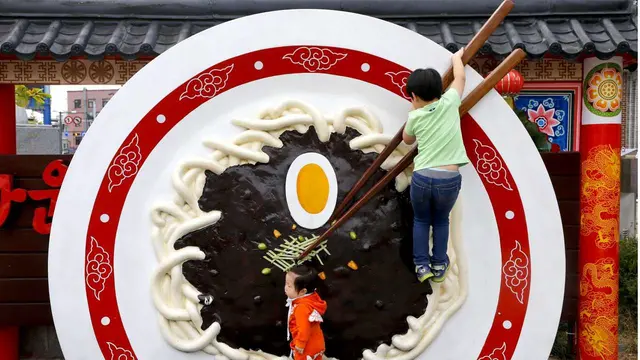On Tuesday, Japan will celebrate White Day, when men give gifts to the women who gave them chocolate on Valentine’s Day, a month earlier.
South Koreans celebrate these days, too, but have added a tradition of their own – Black Day. On April 14, single Koreans – dressed in black – get together to “wallow in their grief” over bowls of jajangmyeon (black bean sauce noodles), which has its roots in China.
Black Day isn’t the only day on which people eat jajangmyeon, however. It is one of the most popular Korean-Chinese dishes, and as central to the Korean identity as
kimchi
, according to Yang Young-kyun, a professor of anthropology at the Academy of Korean Studies, in Seongnam, and author of an academic paper titled, “Jajangmyeon and Junggukjip: The Changing Position and Meaning of Chinese Food and Chinese Restaurants in Korean Society”.
A bowl of jajangmyeon.
It’s generally accepted that jajangmyeon is derived from the Chinese zhajiangmian. While both are tossed noodle dishes with a thick meat sauce, zhajiangmian is usually based on soybean paste, whereas the Korean dish uses fermented black bean paste. Zhajiangmian is popular in northern China, and the proximity to the Korean peninsula (the east coast of Shandong province is only about 700km away from the west coast of South Korea), as well as trade between the countries, especially through the port of Incheon, are likely reasons for the dish having travelled between the countries.
China and Korea have a long history of trade, invasions, military alliances and immigration, but scholars such as Yang believe it was the emergence of restaurants in the early 20th century – in particular, upscale Chinese eateries serving wealthy Chinese and Japanese merchants – that led to the invention of Korean-Chinese cuisine as we know it today.
Until the 1970s, Chinese restaurants were often the only “foreign” eateries in South Korea, and their exoticism made them the default choice for special occasions, such as birthdays. Many Koreans have fond memories of celebrating with “Koreanised” versions of Chinese food, such as jajangmyeon and tangsuyuk, a dish of breaded, deep-fried meat (usually pork or beef) served with sweet and sour sauce.
Korean-Chinese food has since become far more affordable. It’s a home-delivery favourite and banchan (Korean side dishes), such as kimchi and danmuji (yellow pickled radish), are delivered alongside the mains.
(SCMP)
 简体中文
简体中文

